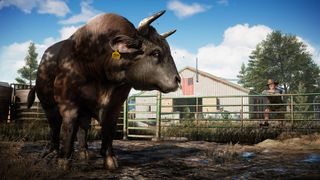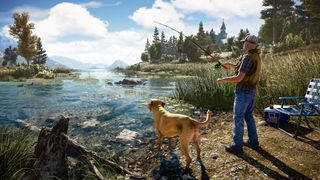Far Cry 5 first look: Taking on doomsday preppers in backwater Montana
Ubisoft brings the series to Big Sky Country, where a heavily-armed religious cult has taken root.
I sat front row while Dan Hay, the creative director for Ubisoft’s Far Cry 5, talked about visiting the place I grew up like it was another planet. And I guess it really is. Montana, the setting for the next Far Cry, is one of the biggest states in the USA with one of the lowest populations. I remember when we broke one million. My dad texted me, saying we’re big time now.
Big is right. There’s so much empty space in Montana, it doesn’t always feel attached to the rest of the US—a perfect home for the strange, fringe, and fundamental. Montana is where the Church Universal and Triumphant started, a cult that performs eerie mantras to assure the stability of personal and national economies. Pinesdale is fundamentalist Mormon sect that actively practices polygamy, just a short drive from Missoula, one of the more progressive cities in the state. And in recent years Whitefish became the begrudging home to Richard Spencer, an oft-punched figurehead in the resurgence of neo-Nazi sentiment. Montana is an easy place for entire communities to mobilize and hide in plain sight, some harmless, some clearly not.
That’s the thrust of Far Cry 5, set in the fictional Hope County, where a powerful cult takes root and flourishes. During a tight-lipped preview event last week in Santa Monica, I got to see a bit of the game in action and talk to Dan Hay about how and why Far Cry is making the transition to a more domestic setting.

A quiver runs through it
Videogames have been casting every shade of brown as the bad guys for as long as I can remember, giving the player big guns and saying ‘go!’ in the foreign country of the week. But in Hope County, Montana, it’s you against small town America doomsday preppers.
Hay and the team were inspired by the unrest and confusion felt after events like the Cold War and 9/11. Such moments represent the United States at its most vulnerable, a far cry from the utopic, efficient, proud country its leaders so often claim it to be. But in the wake of uncertainty, events like the occupation of the Malheur National Wildlife Refuge by an armed militia in Oregon early last year prodded at the idea of a governing body that didn’t have the interests of regular people in mind, and one that wasn’t prepared to respond during a catastrophic event on US soil. What if some people knew a collapse was coming, but didn’t want to wait for the fall? What if one of those movements were run by competent, truly prepared people? They’d probably find a nice and quiet place to get ready.
Far Cry 5’s bad guys are made up of such a militia, a group of extreme cultists led by a bizarro, heavily bearded family. At the head of the family is Joseph, a character we don’t know much about yet besides his apparent magnetism. He’s the ‘father’ of the group, which must be a symbolic title because he doesn’t look old enough to be anything but a brother to the rest of the family.
“Our intention was to build a leader and to build a single idea where this person really did believe in the end of the world and does believe that the end of the world is going to happen. And we heard that from our cult expert that there's a lot of this language in cults and that it was landing in Montana, and that you could drive there and experience it. That's super powerful.”
The biggest gaming news, reviews and hardware deals
Keep up to date with the most important stories and the best deals, as picked by the PC Gamer team.

Montana makes sense for a cult as much as it does for an open world videogame. “We look at a place, and we go, could we believe a Far Cry experience could happen there? As beautiful and lush and even exotic in a strange kind of way, Montana checked all the boxes for that.” Hay told me. Pine forests, predators, and paddywagons abound will no doubt make for a fun, pretty open world to explore.
And visually, Far Cry 5’s Montana looks spot on. I can nearly recognize the bluish mountain ranges gently sloping into lush river valleys . A few small towns break up the monotony of dirt roads and pine trees, and cows stand idly by, flicking their tails and moo-ing to passersby. There’s a bar called the Spread Eagle that recalls Butte’s Sagebrush Sam’s, and the logo for Whistling Beaver Lager looks like something The Great Northern Brewing Co. out of Whitefish would make. Old beater pick-ups, tractors, cows, men with cut sleeves—at a glance, it’s home.
From the little I’ve seen, Hope County, Montana isn’t just Far Cry with a new skin, but it may muck up Montana’s guts. It doesn’t appear to be representative of the people from the area. Members of the nearby Flathead and Blackfeet tribal nations may not be in the game at all, despite their fundamental importance to Montana’s identity. When I asked if they’d show up, Hay said, “I think because we're making it our own world, we're making sure that our characters and the people that are represented are of our world.” If that world is nothing but gruff, white 20-somethings attaching guns to pick-up trucks and crop dusters, it might be too shallow and misrepresentative to be convincing.
I hope I’m wrong, because the contrast between postcard National Park Americana and all out domestic warfare is striking, a surprising fit for Far Cry’s light combat sandbox.
Big Cry Country
We didn’t get any hands-on time with the game, though a few sizzle reels ran a bit opposite to the deadly-serious tone of the presentation, showing off a familiar-looking Far Cry with a few rural flourishes: the player driving a tractor into an enemy outpost with guns blazing out window, a dog stealing a gun from an enemy, a small-town shootout with between hired mercenaries and cultists. We’re still going to run around a vast, gorgeous outdoor environment and take out the bad guys. We’re just going to do it in new places with a few more tools, like Mustangs (the car, not the horse, but who knows?) and fly-rods at our disposal. Just don’t call it rural Grand Theft Auto like I did.
Hay steered away from the comparison, “If you played FC3 and FC4 and Primal and you know what's in our DNA, I think that you're going to step into Far Cry 5 and you're going to understand it, and it's going to feel familiar and nuanced.” It won’t be a total retread, though. Hay continued, “There are going to be key moments that we put into the experience where we go in different directions, and the reflexes that you maybe had in those games will be challenged it a bit and you'll experience something fresh.”
I’m guessing he’s not talking about landing a fresh rainbow or a cutthroat trout, though you can hunt and fish this time around. Is it possible to make an ammo pouch out of trout skin? It might have to be, considering Montana’s fauna is likely going to be less varied than previous Far Crys. Black bears? Check. Grizzly bears? Check. Wolves? Check. Big-ass killer birds? I once saw an emu farm outside of Anaconda, but that’s it.

In saying goodbye to big birds, Far Cry 5 is taking on a new kind of beast: US politics. Because Far Cry 5 is set in the same neighborhood of Montana as pockets of white nationalists and focuses on enigmatic, intoxicating leader types, it’s hard to separate the setting and imagery from the fringe groups that actually exist there. Hay wouldn’t say whether genuine white nationalist groups inspired the direction of the cult in any way, but looking at the key art released earlier this week invites some obvious comparisons. “In terms of the specific push on whether or not about it was about something like what you were asking, we stayed clear of that simply because it didn't feel right for what we were doing.” said Hay. Then what are they doing, I wonder?
I highly doubt Far Cry can be the delivery mechanism for a genuine depiction and commentary on anything going on in the US today—but I’d love to be wrong. With five games to build off of, there’s little doubt it’ll be a fun game to play, I just think the setting and story concepts will invite more scrutiny and criticism than ever before. I’m happy that we’re not shooting enemies in the foreign country of the week, though. It’s the best way to confront the disconnected shooter tourism flaws of the first games. Either way, Hay told me he doesn’t want to make a point, opting to arrange ideas and people for the player to sort through themselves. “The intention is not to preach or to espouse the virtue of a single idea, it's to pepper the world with different people with different perceptions and things, and to allow the player to experience those, and amass experience to form their own opinions.”
It’s an apolitical approach to a patchwork political conflict, clearly drawn from modern tensions over the omnipotent arm of federal government, control of natural resources, the role of Christianity in American culture—and maybe race. Setting up conflict, then backing off and letting the player arrive to their own ideas—a crop duster with a minigun hastily attached to its underside as their goggles into the world—doesn’t sit too well with me. Far Cry 5 is the most interesting approach Ubisoft has taken in years, but if they completely wash over the real inspiration for the setting, it'll feel meek and disingenuous.
James is stuck in an endless loop, playing the Dark Souls games on repeat until Elden Ring and Silksong set him free. He's a truffle pig for indie horror and weird FPS games too, seeking out games that actively hurt to play. Otherwise he's wandering Austin, identifying mushrooms and doodling grackles.
Most Popular


